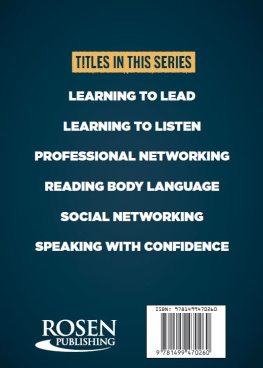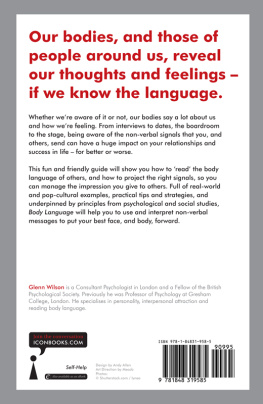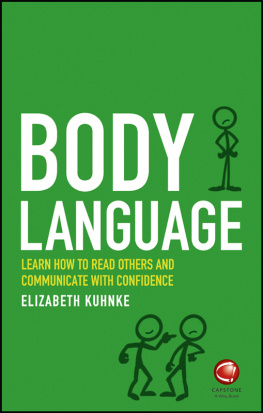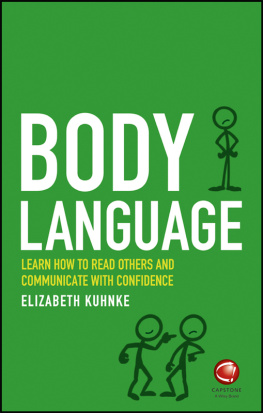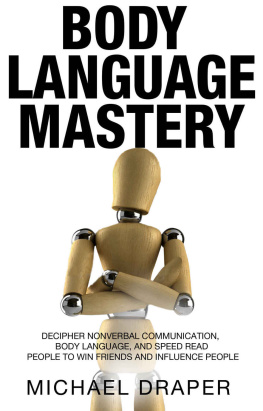BODY LANGUAGE IN BUSINESS
Also by Adrian Furnham
Reaching for the Counter (1993)
Business Watching (1994) (with Barrie Gunter)
The Myths of Management (1996)
Corporate Culture Shock (1997)
The Psychology of Managerial Incompetence (1998)
Body Language at Work (1999)
The Hopeless, Hapless and Helpless Manager (2000)
Children and Advertising (2000)
The 3D Manager: Dangerous, Derailed and Deranged (2001)
Growing Up with Advertising (2002)
Mad, Sad and Bad Management (2003)
Binge Drinking (2003)
Management and Myths (2004)
The People Business (2005)
Dishonesty at Work (2005) (with John Taylor)
Management Mumbo-Jumbo (2006)
Head and Heart Management (2007)
Management Intelligence (2008)
Dim Sum Management (2008)
The Elephant in the Boardroom (2010)
BODY LANGUAGE IN BUSINESS
Decoding the Signals
Adrian Furnham
&
Evgeniya Petrova


Adrian Furnham and Evgeniya Petrova 2010
All rights reserved. No reproduction, copy or transmission of this publication may be made without written permission.
No portion of this publication may be reproduced, copied or transmitted save with written permission or in accordance with the provisions of the Copyright, Designs and Patents Act 1988, or under the terms of any licence permitting limited copying issued by the Copyright Licensing Agency, Saffron House, 610 Kirby Street, London EC1N 8TS.
Any person who does any unauthorized act in relation to this publication may be liable to criminal prosecution and civil claims for damages.
The authors have asserted their rights to be identified as the authors of this work in accordance with the Copyright, Designs and Patents Act 1988.
First published 2010 by
PALGRAVE MACMILLAN
Palgrave Macmillan in the UK is an imprint of Macmillan Publishers Limited, registered in England, company number 785998, of Houndmills, Basingstoke, Hampshire RG21 6XS.
Palgrave Macmillan in the US is a division of St Martins Press LLC, 175 Fifth Avenue, New York, NY 10010.
Palgrave Macmillan is the global academic imprint of the above companies and has companies and representatives throughout the world.
Palgrave and Macmillan are registered trademarks in the United States, the United Kingdom, Europe and other countries.
ISBN 9780230241466
This book is printed on paper suitable for recycling and made from fully managed and sustained forest sources. Logging, pulping and manufacturing processes are expected to conform to the environmental regulations of the country of origin.
A catalogue record for this book is available from the British Library.
A catalog record for this book is available from the Library of Congress.
10 9 8 7 6 5 4 3 2 1
19 18 17 16 15 14 13 12 11 10
Printed and bound in Great Britain by
CPI Antony Rowe, Chippenham and Eastbourne
For Alison and Benedict of course (AF)
For my parents (EP)
LIST OF FIGURES AND TABLES
FIGURES
TABLES
PREFACE
This is a second edition of a short book on a similar topic. It sold very well but needed updating and extending, which was, overall, both an interesting and an amusing task. This now greatly expanded book contains material from the first edition and other pieces we have written on related topics. However, we have revised and integrated this material into what we hope is both a useful and exciting new book. We have attempted to write an approachable, popular, but not misleading, book.
Judging by the number of popular books we found, bought and read on this topic it appears that a great number of people are interested in body language. This is not that surprising, given its intrigue and ambiguities. We all appreciate how important it is as a medium of communication. As we point out, there is a great deal of nonsense written about body language. Academic studies have been misinterpreted; evidence-free assertions made; and exaggerated claims spread around. We have endeavoured to produce a useful and practical guide to body language which is informed by the research on the topic. Enjoy.
ADRIAN FURNHAM
EVGENIYA PETROVA
Every effort has been made to contact copyright-holders for work used in this book, but if any have been inadvertently overlooked the publishers will be pleased to make the necessary arrangements at the earliest opportunity.
1
INTRODUCTION
This book is about body language: signals we send out and receive, messages we transmit and decipher, and statements we make about ourselves nonverbally. Body language is the most primitive system of communication that we share with other species in the animal kingdom. We use it extensively to exchange information about our claim to territory and status, as well as our mate preferences and deepest desires. We use it in the boardroom and the saleroom, to great or little effect. We send out and decode messages of interest and concern, hope and despair, belief and disbelief in the office every day. It is the language we all speak regardless of background or upbringing. It is in our DNA: it is a part of our human nature, the very stuff of communication.
Of course, it is not all there is to communication. Verbal, spoken language and linguistic abilities are much more complex and ubiquitous phenomena that let us articulate such concepts as spacetime, religion, love and beauty. Nevertheless, some things are often easier to express by means other than, or in addition to, words and sentences. Emotions, in particular, are hard to put across verbally (or all the talking therapies would have been dead by now), as are expressions of abstract beliefs. Pain, for example, is difficult to describe, as are complex shapes without the use of gesture.
In this book we seek to clarify a few issues. First, we pose and answer the question: What does it entail to communicate via body language; what sort of information do we send, to whom and under what circumstances? Chapter by chapter we introduce and evaluate the different media of nonverbal messages. Gestures, body positions, facial expressions, vocal tones, touch, smell and even our taste in clothes convey messages about who we are and how we feel.
Second, we deal with the issues of how body language can be used and, regrettably, sometimes abused, to mis-communicate. There is much confusion (and dare we say nonsense) about how to interpret nonverbal signals. Hence a delicate balance needs to be struck between reading too much or too little into small (or large) body signals. Further, while we all praise ourselves as natural man and woman watchers, we are particularly susceptible to trusting fake body language. We include a comprehensive section on lying and how to detect it that deals with this issue.
Finally, we choose to concentrate on practical applications of these facts and observations to the world of work and business. Whether you live to work or work to live, you must have had to meet, negotiate, present and sell (yourself, your ideas or products) at some point in your career. Body language is important at work, from the selection interview to the farewell speech. Awareness of, and ability to manage, ones own body language and read that of others is at the heart of business success, whatever the business. Nonverbal communication (NVC) is also the essence of political propaganda, PR, marketing and advertising, and understanding how these silent signals work can be a crucial asset to business as well as to consumers education.
Next page



